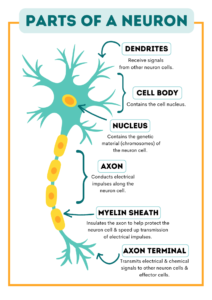Structure of a typical neuron:

-
Cell Body (Soma):
- Function: The cell body contains the nucleus and organelles needed for the neuron’s survival and function. It is responsible for maintaining the neuron’s health and synthesizing proteins and neurotransmitters.
- Components:
- Nucleus: Contains the cell’s genetic material (DNA) and controls cellular activities.
- Cytoplasm: The substance inside the cell body, where metabolic activities take place.
-
Dendrites:
- Function: Dendrites are branch-like extensions that receive signals from other neurons or sensory receptors. They carry incoming electrical impulses toward the cell body.
- Structure: Dendrites can be highly branched, creating a large surface area for receiving signals.
- Important Note: The dendrites play a key role in receiving synaptic input from other neurons, allowing communication between neurons.
-
Axon:
- Function: The axon is a long, slender projection that carries electrical impulses away from the cell body to other neurons, muscles, or glands.
- Structure:
- The axon can vary in length, and it can be up to several feet long in some cases (such as neurons running from the spinal cord to the toes).
- The axon ends in axon terminals, which release neurotransmitters to communicate with the next neuron or target.
- Myelin Sheath: Many axons are wrapped in a fatty layer called the myelin sheath, which insulates the axon and speeds up the electrical signal transmission. The myelin sheath is made up of Schwann cells (in the peripheral nervous system) or oligodendrocytes (in the central nervous system).
-
Myelin Sheath:
- Function: The myelin sheath insulates the axon, helping to increase the speed at which electrical impulses travel down the axon.
- Structure: Myelin is formed by glial cells (Schwann cells in the peripheral nervous system and oligodendrocytes in the central nervous system). These cells wrap around the axon in layers.
- Nodes of Ranvier: Gaps between the myelin sheaths where the axon is exposed. These nodes allow for saltatory conduction, a process where electrical impulses jump from one node to the next, speeding up the signal transmission.
-
Axon Terminals (Synaptic Terminals):
- Function: The axon terminals are the endpoints of the axon that make synaptic connections with other neurons, muscles, or glands. They release neurotransmitters into the synaptic cleft (the space between the two cells) to transmit the signal to the next cell.
- Structure: The axon terminals contain small sacs called synaptic vesicles, which store neurotransmitters.
-
Synapse:
- Function: The synapse is the junction where one neuron communicates with another neuron, muscle, or gland. It is where the signal from the axon terminals is transferred to the next cell.
- Structure: The synapse includes the synaptic cleft (the gap between the presynaptic neuron and the postsynaptic neuron or target), as well as the receptors on the postsynaptic cell that respond to the neurotransmitters.